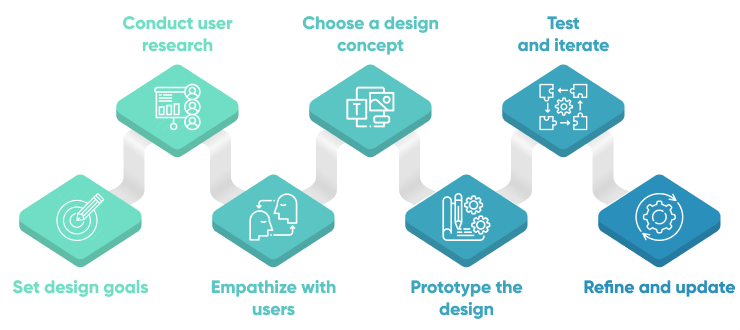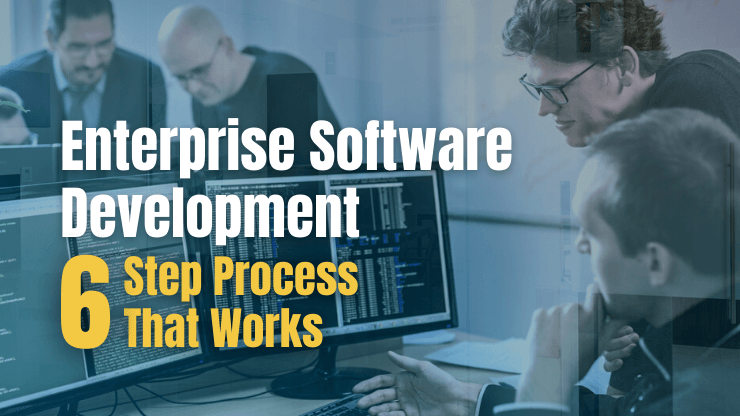It will come as no surprise to you that enterprise software development can be a costly and complex undertaking for any company. And the reality is that large scale software-driven IT projects end up 66% over budget.
With this level of risk on the line, it’s critical that you embrace a development process that’s been proven to work time and time again. That is exactly what we’ll share with you in this article to help you jumpstart your enterprise software development project with confidence.
What is enterprise software development?
Enterprise software development (sometimes referred to as enterprise app development) is the process of creating custom software solutions specifically for a business or organization. This can include anything from enterprise resource planning (ERP) systems to customer relationship management (CRM) systems.
The main goal of building custom enterprise software solutions is to help businesses optimize their operations, improve communication and collaboration between employees, better serve their customers, and overall increase their productivity..
Organizations typically turn to developing custom enterprise software when they are unable to find an off-the-shelf software that suits their internal business demands. In some cases, businesses may opt to customize an existing software to better meet their needs rather than building custom software from the ground up. In this article, we’re going to focus on the former.
Enterprise software (custom and off-the-shelf) typically falls into one of five categories.

Developing custom enterprise software can be a complex and costly undertaking. Businesses must carefully consider their needs and objectives before embarking on a custom software development project. They should also take time to select a reputable and experienced enterprise software development company to support their project and ensure a seasoned project manager is staffed to manage the budget, schedule, and delivery.
6-step enterprise software development process
In our experience, teams who have built successful enterprise software have followed this 6-step process, which roughly aligns to the industry standard software development lifecycle.
Requirements gathering
Before the formal enterprise software development process kicks off, a business need or opportunity should be identified. After the business need has been identified, the enterprise software development process formally begins with requirements gathering.
Requirements gathering is simply the process of collecting, organizing and documenting all functional and non-functional requirements of the proposed software. This process can be led by a project lead or project manager.
It is important at this stage to ensure that the requirements are not met, or could be closely met, by existing applications. Solution architects, business analysts or those with similar skill sets can help in this phase by gathering requirements and examining the existing application portfolio.
It is often wise at this stage to speak more widely across the organization to determine if the identified or similar requirements exist as a need in other areas, to prevent duplicate systems being built or procured and allow reuse of the system.
The key output of this phase will be a business requirements document (BRD) which should contain a list of all required functionality, possibly prioritized using a technique such as MoSCoW (Must have/Should have/Could have/Won’t have now) with appropriate traceability by business area.
Producing a requirements document as part of the software development process can help to:
- Verify that there is a legitimate need for the new enterprise software to be built rather than simply purchasing an enterprise software solution off the shelf.
- Ensure the software development team has complete clarity on the requirements of the proposed business software.
- Provide a high degree of transparency right from the beginning of a project to all stakeholders who may be involved.
- Prevent the final software from needing extensive rework or changes due to missing criteria.
- Validate that the capabilities being delivered by the new software meet the stated needs of the enterprise software project team.
When the project team has produced a requirements document, it’s time turn the requirements into a formal software plan.
Planning and alignment
With your requirements document in hand, it’s time to move forward with more detailed software planning and alignment amongst all parties (internal and external) that will be involved in the software development project. Your output for this stage will be a software development plan.
A software development plan outlines how the project requirements will be turned into working software. It covers planning, ideation, development, documentation, deployment, launch, and maintenance details.
It’s recommended that this stage be completed directly with the software development team that will be working on your enterprise software. Of course, to do that, you need to have selected either an internal development team or decided on a development team to outsource the work to.
The software development plan should answer questions such as:
- What technologies will be required?
- Who will manage the project?
- Which teams and resources will be involved?
- Who are the key stakeholders?
- What are the external dependencies?
- What are the success criteria?
- What are the timelines and how have they been estimated?
- What are the estimated costs and what assumptions have been used to calculate them?
At Softkraft, we guide you through this planning stage via our intense design workshops. During these workshops, we agree on the initial architecture and tech stack, set the milestones for the business and development roadmap, set the dates for upcoming Sprint Demo’s and agree on a time for Daily Standups.
UI/UX design
You have a robust software plan and all stakeholders are aligned on a path forward. Now it’s time to kick off UI/UX design for your new enterprise software. There are many ways to complete the UI/UX design such as by working directly with a full-service software development company, hiring a design agency, or contracting a freelancer UI/UX designer.

Regardless, the UI/UX process for an enterprise software system typically follows this flow:
- Set design goals. Create a design brief that describes the goals and objectives of the project, target audience details, scope of the design, success criteria, and the deadline for the design work.
- Conduct user research. The purpose of user research is to determine the problems the users are facing and what they need to do to resolve those problems. Putting ourselves in users’ shoes helps us find the way they are thinking and behaving.
- Empathize with users. Understand your users’ needs by creating an empathy map, developing personas, or mocking up a sample user storyboard.
- Choose a design concept. During this stage of the process, a UI designer starts creating a digital product’s graphical user interface. This includes defining layouts, deciding the information architecture, creating icons, selecting the color theme, defining typography styles, and setting UI guidelines.
- Prototype the design. With the screen layouts defined, during this stage your team can begin design work in the form of sketches, whiteboard flows, and wireframes to help share the design ideas with stakeholders.
- Test and iterate. A team can test the usability of the prototype as soon as it is finished. Unlike QA testing and A/B testing, the major objective of usability testing is to get opinions from actual users of a product to determine how user-friendly the interface is and whether the user can accomplish their objectives using the product.
- Refine and update. After the release of a product when users start using it, the designers continue their work to keep the product updated as per new UI and UX design trends.
The UI/UX design stage is critical to set up the software development stage for success. A great design will not only take into the users but also what’s realistic to build during software development.
Software development
Now it’s time to build some software! In the build phase, the output of the “requirements” and “design” phases are transformed into working software by your enterprise software development team.
The software will be built in such a way that it provides the functionality specified in the requirements document and the best projects will ensure continuing engagement with end-users throughout this phase to ensure that the things being built are closely aligned with the originally stated requirements.
The actual software development will likely be the longest stage in the overall enterprise software development process. You can expect anywhere from 6-12 months depending on the complexity of the software.
To help you visualize how your own custom software solution could come to life, check out a few real examples of custom enterprise software development here.
Testing & deployment
This is a crucial stage to ensure the working software is ready to be transitioned into the production environment. You can think of this as the gate between development and production, where work is done to ensure the software is meeting expectations and the design is polished and ready for real users.
At Softkraft the testing and deployment stage would consist of:
- Change Requests. We add final touches on the design and implement small things that can have a big impact on how the user interacts with the software.
- User Tests. We run a UX audit and conduct usability interviews with the first users. We analyze their behavior using tools like GA or Hotjar.
- Performance Tests. We test efficiency of the implemented functionality and go through the project test checklist.
- Staff Training. We teach your team members how to admin and use the software in a proper way.
- Documentation. Hand-off We give you all the know-how and the documentation behind your product.
It can be tempting to move straight into deployment, but the finalization and testing work is critical to ensure you’re receiving software that meets all stakeholders’ expectations.
Maintenance & support
You have launched your new software into the production environment and real users begin to enjoy its benefits. But the software lifecycle is not over. All enterprise systems will require some amount of maintenance to ensure they continue to meet expectations.
SDLC and STLC suggest the following be considered to ensure software is properly supported and maintained:
- Environment management. Genuine aggressors misuse design mistakes and weaknesses. Security observing should cover the whole framework, not simply the application. Such observing enhances the general security of your application.
- Incident response plan. An episode reaction plan clearly depicts the methodology that your occurrence group should use to deal with any security breaches that may occur. Quick execution of the reaction plan is pivotal for emergency and fix of safety breaks.
- Ongoing security checks. Security checks should be rehashed consistently for the reason that new sorts of weaknesses are being found at a consistent rate. Standard checks shield your application from newfound weaknesses.
Additionally, you should consider how your users will be supported when issues arise with the software. Will you have an internal IT resource? Or will the outsourced software company provide technical support? Make sure you have a detailed support plan in place.
Key elements of a successful enterprise software application
We’ve walked through our recommended enterprise development process, but what actually makes or breaks successful enterprise applications? Let’s take a look.
Flexible enough to scale over time
One of the key value-adds of developing a custom solution is its flexibility and extensibility as business needs change. Building in software flexibility is important for successful enterprise software for three major reasons:
- To ensure the solution can be easily modified over time. This will allow for adaptability as the business grows, business intelligence needs change, and as broader market and technology changes roll out.
- To reduce the overall cost of ownership. By avoiding the need for costly and time-consuming replacements or software migrations, overall cost of ownership will be lower.
- To improve the overall quality of the software. High-quality development teams will embrace modern development methodologies that prioritize delivering flexible, easy-to-understand software.
The key to building in this level of flexibility is to work with an experienced enterprise development company that can design a software architecture that meets your business needs today and in the future.
Optimized to streamline business processes
Before undertaking enterprise application development, make sure that it will meaningfully help to optimize internal business processes.
To help you gain clarity on the specific business processes that a new software solution can help to optimize you should:
- Interview users of the current software tools to understand all of your unique internal processes that are being handled by these tools. This can help you to understand what real people like and don’t like about the software and how they’re actually using the tools.
- Pull usage reports for existing software tools to understand the processes that are being done in the current tools. This can help you to see not only what needs to be replicated in some ways in the new tool but also where there may be room for optimization.
- Inspect off-the-shelf solutions before building custom software. Make note of things you like and things that are missing or things that wouldn’t work for your specific business infrastructure.
Integrates with tech stack
Every company will have unique software integration needs. Many off-the-shelf enterprise software systems will have some integration services, but they might not be the right ones for your business (or flexible or robust enough to handle complex data).
When building custom software, you get to decide what existing software or enterprise apps the new solution will integrate. Direct integration with other software tools can help improve process efficiency and reduce the overhead of maintaining 3rd party integration tools.
All integrations necessary should be documented during the requirements gathering phase, implemented during the software development phase, and thoroughly tested before deployment.
Conclusion
Enterprise software development aims to provide a custom solution to an enterprise’s most critical internal business needs. It can be a great option for businesses that need something that off-the-shelf solutions do not provide.
While it can be a complex and costly undertaking, businesses can rely on the 6-step process outlined above to ensure they are following industry-standard practices to develop enterprise software that meets the needs of their business and users.

